#chant of light
Text
i know I keep hyperfixating on the Solas/Ghilan'nain flashback but there is SO MUCH to unpack there and I want to talk about the VERY FIRST THING we see when we start the FIRST GAME. (DAV spoilers ahead)
The VERY FIRST

This is the very first thing we learn about the entire setting of the game. It's the foundational piece for the Chantry's concept of sin. And as we learned in one of the random Veilguard videos, The Chantry's interpretation is completely fucking wrong.
The Blight not only predates the first Archdemon, it predates the creation of the Veil and the sundering of magic into The Fade. It dates back to late period Elvhenan.
So where did the Canticle of Threnodies originate? Hint: NOT THE CHANTRY.

Slave uprisings? Oral tradition? Hmm, which people relied near-exclusively on oral tradition for centuries? Who did Tevinter primarily enslave? Who has a history of slave uprisings that predates Tevinter itself? Elves. What happened to the Elves of Arlathan after it fell? Enslaved in the founding of modern day Tevinter.
Ancient Tevinter Slaves (hint: Elves) have an ancient oral dirge about a "golden city" being "blackened", and about a singular pissed off narrator telling someone that their every step blackens the city and brings doom upon the world.
A dirge primarily sung during slave uprisings. Whose big thing was a massive slave uprising or uprisiings in Elvhenan and Arlathan?
I posit that Canticle of Threnodies 8:13 is the Chantry's translation/appropriation of Solas telling off the Evanuris once and for all, and was part of his final rebuke to them before trapping them in the Golden/Black City (Arlathan) and sealing the city off and creating the Fade.
The warning survived into Elven oral tradition as they were then enslaved by the humans in the founding of Tevinter. When the Magisters then breached the Black City and found the blight waiting for them (as Corypheus confirms, although I wonder where the Evanuris were hiding), it was retconned to apply to the Magisters when the original sin...was the Evanuris.
(PS: There are literally dozens of these examples of history retcon all throughout Thedas in past games.)
#dragon age#dragon age origins#dragon age veilguard#veilguard spoilers#dragon age spoilers#dragon age the veilhuard#chantry#the chant of light#chant of light#canticle of threnodies#tevinter#darkspawn#doom upon the world#black city#golden city#dragon age lore#solas#fen'harel#evanuris#magisters sidereal
37 notes
·
View notes
Text
#dragon age poll#chant of light#arlathan#elvhenan#golden city#black city#the fade#dragon age descent#dragon age trespasser#dragon age speculation#dragon age theory#dragon age lore#the crossroads#dragon age#cekorax#tevinter nights#luck in the gardens#heidrun thaig#trespasser spoilers#dragon age inquisition spoilers#rock wraith#darkspawn#the blight
62 notes
·
View notes
Text

"The air itself rent asunder,
Spilling light unearthly from the
Waters of the Fade,
Opening as an eye to look
Upon the Realm of Opposition
In dire judgment."
Exaltations 1:2
#dragon age#thedas#chantry#chant of light#tevinter#imperium#dragon age ii#dragon age mage#dragon age origins#orlais#hero of ferelden#champion of kirkwall#fereldan#dragon age the veilguard#veilguard spoilers#da veilguard#solas dragon age#evanuris
14 notes
·
View notes
Text
Codex entry: Hurlock
"Those who sought to claim
Heaven by violence destroyed it. What was
Golden and pure turned black.
Those who had once been mage-lords,
The brightest of their age,
Were no longer men, but monsters."
—Threnodies 12:1
"Sin was the midwife that ushered the darkspawn into this world. The magisters fell from the Golden City, and their fate encompassed all our world's. For they were not alone.
No one knows where the darkspawn came from. A dark mockery of men, in the darkest places they thrive, growing in numbers as a plague of locusts will. In raids, they will often take captives, dragging their victims alive into the Deep Roads; most evidence suggests that these are eaten. Like spiders, it seems darkspawn prefer their food still breathing. Perhaps they are simply spawned by the darkness. Certainly, evil has no trouble perpetuating itself.
The last Blight was in the Age of Towers, striking once again at the heart of Tevinter, spreading south into Orlais and east into the Free Marches. The plagues spread as far as Ferelden, but the withering and twisting of the land stopped well beyond our borders. Here, darkspawn have never been more than the stuff of legends. In the northern lands, however, particularly in Tevinter and the Anderfels, they say darkspawn haunt the hinterlands, preying on outlying farmers and isolated villages, a constant threat."
—From Ferelden: Folklore and History by Sister Petrine, Chantry scholar
8 notes
·
View notes
Text
Andrastian Design: Tapestry and Tryptich

Even though there is tapestry of each cultural group all over DAI, it’s common to associate tapestry with Ferelden mainly. In game we mostly find in Ferelden houses some of these Tapestries, that like the Stained Glasses of the Chantry, narrate the story of Andraste.
The main reason why I assume these are Ferelden-made is basically because, 1) we find them always inside houses and castles of Ferelden, and 2) by analysing their frame, they are associated with the Ferelden Wyvern.
The frame
Fist of all, let’s see the details of the frame: They are decorated with a beautiful colourful complex set of patterns: dots, geometrical lines, circles, swirls, half-circles, and star-like figures compound it.
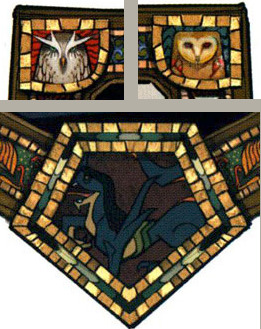
On the top corners we find two different kind of owls.
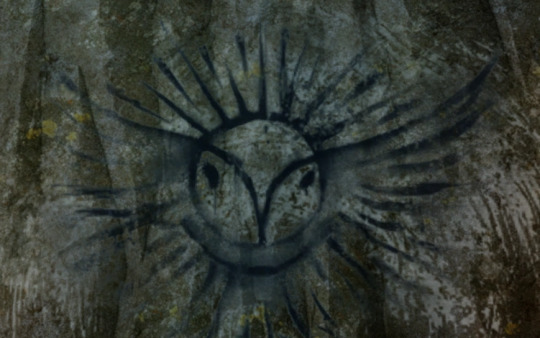
Owls have always been part of Ferelden design because they belong to their alamari heritage, given the important role that the Lady of the Skies [represented as an owl too] have in the alamarri/avvar religion. Since they are also quite close to spirits, I would not be surprised if these owls are also a link to the Elvhenan [we know that a curious pair of birds can be found in the Hidden Armoury [Elven mountain ruins] and there are many owls in Skyhold [specially in the front gates and in the basement library that may or may not be related to the ancient elvhen presence in it] as well as in the Inverted Ward.
In the lower part of the frame, we find a Ferelden Wyvern, which are represented in several places throughout DAI. They are related to a non-official folktale of Andraste that we find in one of the books of World of Thedas. The tale is quite meaningless and shallow [more details in Crestwood]. This detail is the main reason why I think these tapestry are strongly Ferelden made.
The Story of Andraste
1-Unknown Event
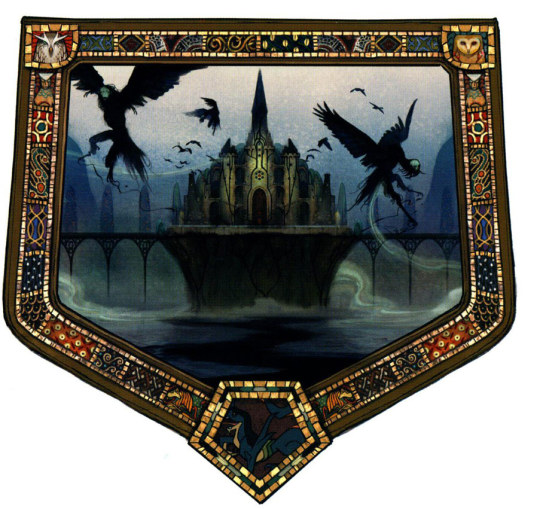
The first of all these tapestries is the one most difficult for me to understand. Based on the Chant of Light, it may represent the dark times alamarri were living; most of their territories were invaded by Tevinter, their resources were stolen and their people were kidnapped and turned into slaves. These strange harpy creatures may be a rare representation of Tevinter preying on Alamarri [it’s very strange since Tevinter is always represented with a snake or a dragon]
On the other hand, we see two bridges and a big elevated structure that makes me remember Ostagar, which was a Tevinter structure to keep the Chasind away from the invaded regions of Ferelden.
Another interpretation is that this may represent the Golden City of the Maker, desecrated with the entrance of the Magisters. We have to remember that Andraste’s Tale comes half a century after the end of the First Blight. Still, it’s a weird representation since it’s not a floating city in the air, but a fortress in an island, with access through bridges, and there is water bellow.
We also know that by that time, Andraste called the Alamarri gods for help, but they remained silent [meaning, neither the Lady of the Sky, nor Korth, nor Hakkon answered her] and this scene may represent the despair that such situation may have caused.
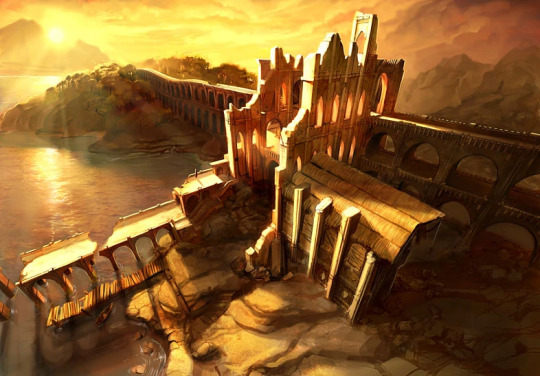
Finally, as a last interpretation, this structure may be Kinloch Hold, where the current circle of Magi of Ferelden is located. The original construction was built by the Avvar with some help from dwarves. It served as a fortress and a watchtower and was long considered impregnable until the Tevinter Imperium drove the Avvar from it in a brutal campaign. Maybe this image represents Kinloch Hold but surrounded by harpies and despair due to the lack of answer of the gods while the avvar were attacked by the Tevinter forces.
In any case, I can’t totally trust 100% any of these interpretation. The drawing is very strange for the lore we were given.
2- The Maker speaks to Andraste

Without the answer of her gods, Andraste roamed the forest of Ferelden until the Maker appeared. Here we can see once more the figure of a man, without face, covered from toe to head, only wearing a crown. He is presented with a glow of green and golden, making his connection to the Fade a bit subtler in this drawing than in the Stained Glasses.

His veil has a pattern of what I think it’s a rose or a flower with vines, but sadly it’s not easy to see the details. I could not find a better quality image for a decent zoom-in.

Over him, we see the moon with three borders, and I can’t avoid making a connection with the murals of Solas [Murals in DAI] where the Veil is represented with thick borders. This is very curious because in the other tapestries the moon appears like a normal element in the drawing, so this representation emphasises to the Player [not to the people inside Thedas] that there may be some special relationship with the moon. It’s also worth noting that the moon has a yellow/golden border same as the figure of the Maker, and golden decorations are usually related to godhood [at least inside the elvhenan context].
This scene represents the verses of Andraste 1 [Chant of Light - Part 1] where the Maker claims that the world has forgotten him, and invites Andraste to join him to the Golden City and leave the sorrow behind, but Andraste asks him to forgive humanity. He accepts, promising his return if his children listen to her.
3- With Maferath, Andraste leads the Exalted March against Tevinter
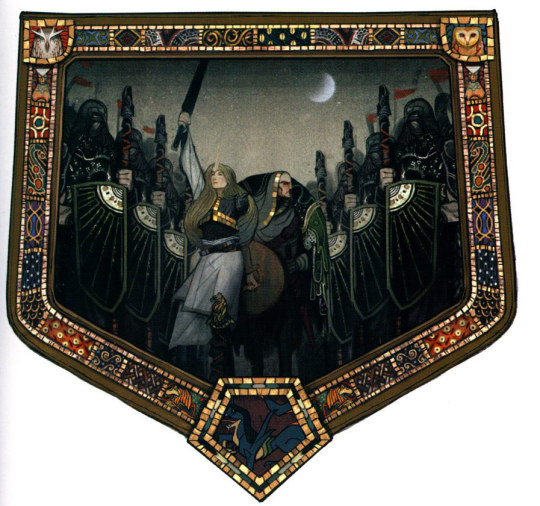
Here, Andraste and Maferath lead an Exalted March against Tevinter in order to spread the word of the Maker and stop Tevinter oppression all over the alamarri lands. We see in this tapestry several alamarri warriors using a shield with the symbol of the Sun and hilts with wolf/mabari shapes. Again, the mabari is a Ferelden icon, while the Avvar prefer the wolf, since it’s an animal of freedom and not tamed as the hound [A Plea from the Warrior to the Spirits]. Depending on how we perceive the alamari around Andraste, this hilt can be also a subtle elvhen symbol of rebellion. I insist in relating the Avvar/alamari with the elvhen simply because their perception of the world of the spirits gave them similar wisdom than the Elvhenan.
Andraste is also wearing her typical one-spiked crown. Behind her we can see Maferath. She and Maferath wear a common element: a series of golden tiles around their chest or veil to emphasise the link they have: they are the leaders guided by divine words in this “divine” march against Tevinter.
Also, notice how different the moon is represented in this tapestry in comparison with the previous one.
4- Andraste fights in Tevinter territory

This seems to be a depiction of a battle close to Minrathous. The background shows typical Tevinter buildings. On the left side of the tapestry we can see Tevinter warriors being killed by arrows [probably a subtle calling of Shartan presence], while Andraste, as a [superheroe] warrior, jumps in the air.
Behind her, we see a lightning and a dark cloud, suggesting three potential things: when we read about the role of Shartan and the elves, their contribution is usually described as the responsible for creating “dark clouds of arrows that fall upon the enemy”.

The other interpretation, more andrastian, is that the Maker presence is there, helping them in battle. Finally, in the last interpretation, this cloud may be a representation of Andraste’s magical powers [in DAO we have the icon of Tempest looking similar to this: clouds and lightnings]. There is a glowing circle behind her face similar to the moon in the previous tapestry. These details may reinforce the idea of Andraste as a prophet of the Maker, or as a mage [specially if we read about her childhood with that strange episode of her half-sister dying in a fire, in the middle of the forest, implying that Andraste may have lost control of potential magical powers or was possessed by some spirit; the interpretations of this vague episode can go wild].
On the right side of the tapestry, I can see a statue that I suspect is of Nevarran origin [Egyptian-like design], meaning this battle may have been close to the borders of Tevinter and Nevarra.
Again, like in the post of Stained Glasses, I don’t find a particular group of verses where Andraste narrates her movement across Ferelden, the Waking Sea, and Nevarra to attack Tevinter lands. The closest verse to this action is in Shartan Verses [Chant of Light - Part 2] but also historical battles are implied in Hymns and Transfigurations [Chant of Light - Part 1] where Andraste prays to the Maker before heading to combat. It is curious that there is no verses about the “travelling” part of Andraste and her armies, not even when crossing the Waking Sea and Nevarra in which land there are some tales going on as we saw in Emprise du Lion: Pools of the Sun with her supposed Nevarran disciple/lover Hector. In fact, in this local tale, the event of the betrayal is placed there, in Nevarra and not in front of Miranthous ready to lay a siege [hence my complete confusion about where exactly this betrayal happened, and if any siege to Miranthous truly happened].
5- Andraste is handed over to Tevinter

In this scene we see when Maferath hands over Andraste to Tevinter. Since in the previous tapestry we see hints of Nevarra, and then we have this tapestry of the betrayal, we can assume that the tapestries narrate Andraste’s story in a way that makes Hector easy to be included [check Emprise du Lion: Pools of the Sun], while the Stained Glasses seem to remove any presence of Nevarra in her story. But the Stained Glasses have the presence of Shartan, which has been completely erased in these tapestries, making me suspect that maybe these tapestries keep the tale of Andraste with a strong Ferelden vision, probably closer to the most ancient versions of her tales [likely before the Long Walk of the free elves to the Dales, time when the tale of Shartan appears as we saw in The Chantry and the Mythology of the Chant of Light].
Here, we see Andraste being held by two Tevinter guys who look very evil. Like in the Stained Glasses, Havard is not here either. According to the Chant of Light, The Aegis Havard was supposed to be here, and unable to fight his Lord Maferath as well as to hand Andraste over to Tevinter, he puts himself in between Andraste and the evil Tevinter and ends up deadly wounded [Chant of Light - Part 2].
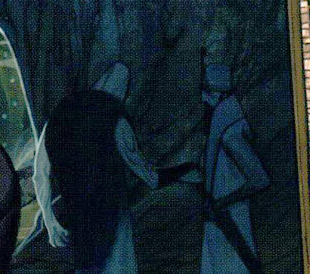
In the shadows, representing the secret arrangement, we see Maferath giving a handshake to Archon Hessarian.

Behind them, a snake passes by: it has the tip of the tail golden, continues black, and then it turns out white. I’m not so sure if this means the transition of Archon Hessarian, from worshipping Old Gods, to kill Andraste, and then repent and became an Andrastian follower himself.
In the background, we see more Tevinter buildings with “evil” red glowing windows.

The moon has a similar style to the one we saw in the tapestry with the Maker, but its borders are smudged. The colours seem to be the same ones but desaturated and muddy.
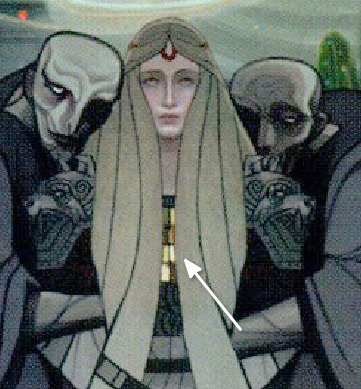
I’m not sure if this represents some “lack of presence of divinity” since Andraste’s golden tiles are also hidden below her hair, giving the idea that the Maker abandoned her. She is not wearing her typical one-spiked crown either.
This tapestry represents the verse of Apotheosis 1 [Chant of Light - Part 2].
6- Andraste is killed

In the next tapestry we see the public execution of Andraste in a pyre. The background shows Tevinter buildings, suggesting this is Minrathous.

On the left we see Havard, the avvar warrior who is wearing a klimt-yellow robe. He is looking down, lamenting this situation. He is not “deadly wounded” as the Chant says. It seems that in this Ferelden version, Havard never was in the moment Maferath hands over Andraste, so he appears safe and sound at the moment of her execution.
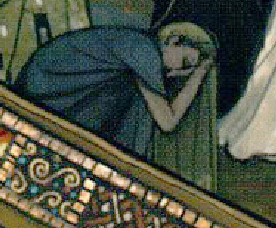
Close to Havard, we see a woman, kneeling as she cries, that maybe is Justinia, the original one. I guess this because it makes not much sense to add a random woman in this scene; all the characters present in this image have a relevance in the story of Andraste.
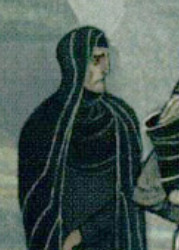
There is also a Tevinter man in black robes who also seems sad about this execution [Is this Trefir? the Archon’s slave who left Tevinter carrying the Sword of Mercy and was supposed to found the Blades of Hessarian?, more details in “The Chantry and the Mythology of the Chant of Light”]. I’m surprised of seeing another “sad Tevinter” considering this is made by Ferelden and one would expect a more anti-tevinter propaganda.
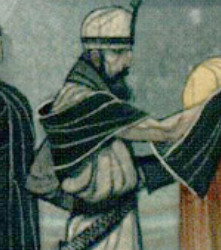
In the centre we see Archon Hessarian, wearing a white robe, the same white that Andraste. This is very unusual given the typical dark outfit of the high hierarchy in Tevinter, so I’m inclined to interpret his figure here as “a purification” that the Archon experienced when he killed Andraste out of Mercy. If Andraste was purified by fire, the Archon was so by his merciful act. Again, a veeery rare representation of Tevinters, specially coming from a Ferelden source. As the Chant claims, he is sinking his sword in Andraste’s heart to give her a merciful death.

In the pyre, Andraste’s bleeds to death, tingeing her hair of red too. she still wears a minimal line of golden tiles.

On the right side of the tapestry, we see Maferath, leaving the scene with some facial gesture of regret, while holding in his hand a crown, that may represent the Maker, as if “he removed the Maker influence in this story”, or more likely, to “recover” his leadership of the alamarri.

I think this crown has one longer spike, so it may be Andraste’s crown, but it’s not the same crown that Andraste uses in previous tapestries, so the interpretation is a bit more loosely. Ferelden art depicts Andrates’ crown in very different ways.
The verse that this tapestry represents is Apotheosis 2 [Chant of Light - Part 2].
7- Andraste ascends

Here we see the ascension of Andraste to the Maker���s side. Also, notice that this tapestry shows a normal moon too.
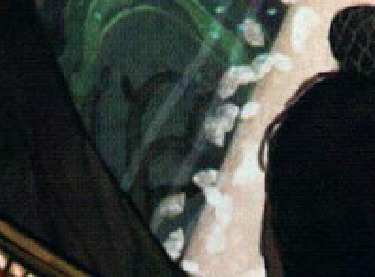
The background displays two tree, one of them looking a bit like a thorny vine. There is a sky full of stars. An intense white light wraps her and makes her raise. She is wearing white, implying how the fire purified her. Below her, we see Maferath and Archon Hessarian, surprised.
The verse represented in this image is the last part of Apotheosis 2 [Chant of Light - Part 2].
8-Havard takes Andraste’s ashes

In the last tapestry, we see Havard, wearing this iconic klimt-yellow robe, carrying Andraste’s ashes in the night, leaving Miranthous/Tevinter. We will know later that he went to the Frostback Mountains to build Haven, founding the Temple of Andraste that later will be developed into the Disciples of Andraste.
The verse represented in this image is the last part of Apotheosis 2, [Chant of Light - Part 2], even though it is curious that the Chant claims that Havard was healed by the ashes of Andraste, while we see in the tapestries that he was not even hurt. It’s also curious he looks more like a mage [yellow robe and staff] than an avvar warrior.
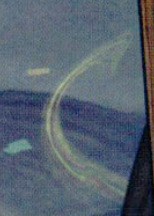
Many of these tapestries, including this one, display small lines of green in the scenery as if it were mist, but they give an eerie feeling to the drawing, almost a subtle Fade-y effect.
The Orlesian Triptych
Why do we assume this is Orlesian? Simple: it’s not only over elaborated, it has a Quincunx design in it [more details below] which is present in the Orlesian design of rugs,
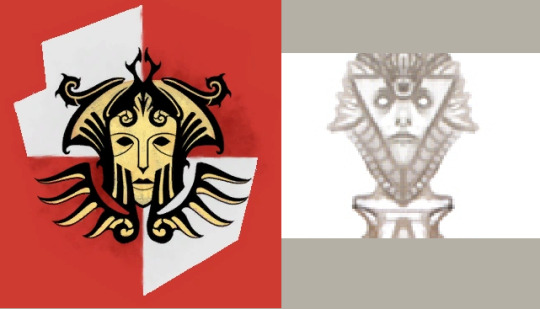
and has the typical triangular face of Orlais, that may represent Andraste [we find it in many sculptures of Orlais], Celene or Drakon’s Heraldry. I cannot point out exactly who is this triangular face, but all these options look reasonable in my opinion.

The Orlesian triptych is focused on the execution of Andraste and her later ascension.

At the top we see three iconic symbols in circles: in the centre, below the Orlesian face [or Drakon’s heraldry, I never know], we find a circle depicting the Golden City. At the right side, the typical icon of the six snakes with that little polygon in the middle, which used to be the typical symbol to represent Tevinter in a more “arcane” way [ check Nation Art: Tevinter].

On the left side, we find a simplification of a Ferelden symbol we found in Nation Art: Ferelden, which shows a face crying. I assume this is a representation of Andaste’s face in a Ferelden style or a vestige of a Sun-based religion before the alamarri trinity religion.

As apparently Orlesian design implies, the triptych shows the 3/4 of a Quincunx, completing the fourth circle on Andraste’s heart. Therefore, the middle of the complete Quincunx would show the face of Andraste wearing her typical spiked crown. The Quincunx has been quite a repetitive element in DAO, being forgotten in later games. In DAI we only see it in Solas’ Tarot Card, and in some Orlesian designs that are seen in the concept art but not inside the game so far I’ve seen.

Below the Ferelden symbol, we see Maferath. He is wearing a crown of three spikes, a bit squared. He can’t see the light that Andraste radiates. Ironically, he is drawn in a more darker and evil way than the Archon, which is surprising for me, since Orlais did not show a strong negative sentiment towards Maferath as Ferelden does [in the Hinterlands, we see in very raw sculptures the strong rejection that Ferelden has towards him in general]. Instead, I was expecting Orlais, headquarters of the Chantry religion, to be more negative towards Tevinter because their Imperial Church.

Below the symbol of Tevinter, Archon Hessarian looks at Andraste, unbothered by the radiance, ready to use the sword as we can see his hand ready, close to the hilt of the sword at his waist. A white snake is surrounding him, probably as a symbol of his change of heart that gave him some level of “cleansing”.

The two panels are separated by a sword that lays over the burning body of Andraste: this is the Sword of Mercy that we see in many other pieces of art. Curiously, it’s the same sword that the Tevinter Warrior holds in the statues Female Kossith/ Desire demon /Tevinter Warrior which decorate the columns of the Imperial Highway. This makes me suspect, in combination with such a positive view over Tevinter elements, that maybe this triptych is older than i expected, maybe older than the Schism of the Chantry. However, we have no information to confirm or debunk it, sadly.

When we open the Triptych, we can see Andraste, purified [wearing white] and the sun behind her.
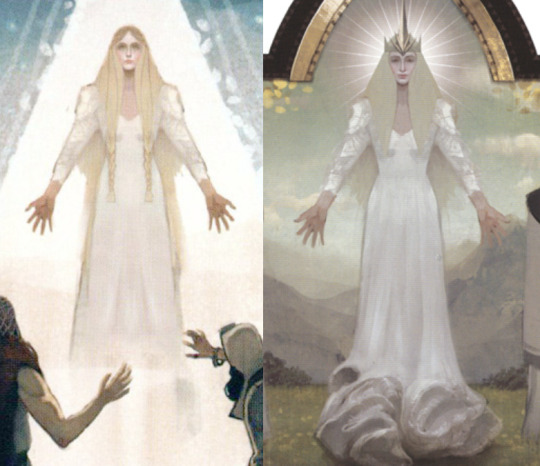
This figure is a copy of the tapestry of the ascension of Andraste: I mean, from a design point of view, the designer copy-pasted the same Andraste and altered it a bit, meaning that one of these pieces of art if the copy of the other.
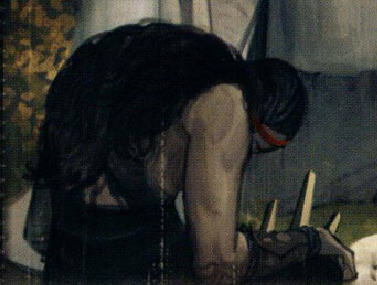
On the left, we see the Ferelden side: Maferath is kneeling down, defeated, regretful, with his crown on his lap.

The Chantry hierarchy can be easily seen here represented by the three people lamenting Andraste’s death and looking down at Masferath: Sister/Brother and revered Mother.

Beside Andraste, we see the “white” Divine, the Divine with main residence in Orlais.

On the right, we have the Tevinter side, mirroring the left side: we see that Archon Hessarian is on the ground, regretful, in similar position to Maferath. He, as well as Maferath, wears a red cord in his head that was not present in Maferath’s head in the previous image. I don’t know what it could mean, since it stands out a lot in the drawing of dark and white colours.

Behind him, we see a group of Tevinters that I assume belong to the hierarchy of the Imperial Chantry. Just by the outfit, we can see a magister, and probably a Revered Father and a sister.

I assume this one marked in the image is the magister simply because he wears similar to the Magister Erasthenes that we meet in Orlais: Shrine of Dumat.
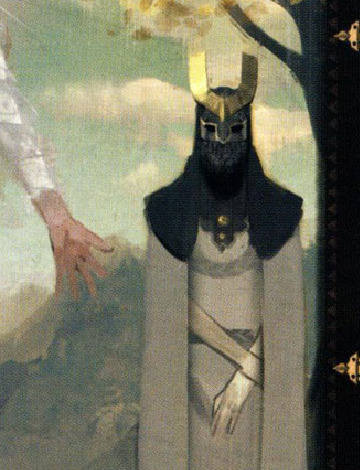
Beside Andraste, if I’m not mistaken, we can see the “Black” Divine, the imperial Divine. The curious helm he uses reminds me a lot of the mysterious symbol we found in Hinterlands: The Unknown Ruin.
Now, this Triptych is astonishing and mega-surprising for the presence of the Imperial Chantry in equality to the Orlesian Chantry, “Black” Divine included, since he’s considered a “false” divine. So, I think that this triptych, usually seen in Orlesian places, is quite subversive. I’m sad we don’t have much information about who painted it and when, because, again, to place the Imperial church in the same level than the orlesian Chantry, mirroring it no less, it’s very, very strange.
#andraste#andrastian design#maferath#hessarian#archon hessarian#chantry#chant of light#sword of mercy#ferelden design#Ferelden Wyvern#owl#Quincunx#the sun symbol
31 notes
·
View notes
Text


These two belong together. Would have felt wrong to upload them seperately, so don't mind me getting them up in a tandem.
There aren't too many alternate versions of the Soul of Justice Clover Wayne known. For the most known one you even have to leave the Underverse to find them. Fittingly that one ended up in the just the fandom that we are also honoring here in this challenge. Thus don't mind me using that perfect opportunity to draw the connection line between Wayne and Trevelyan. Just the perfect opposites for these two prompts.
#undertale#tales of the underverse#inktober#dragon age#dragon age inquisition#yellowfell#underfell#Justice#Soul of Justice#Karl Wayne#Carl Trevelyan#Inquisitor Trevelyan#Clover#Clover Wayne#Demon#Angel#Chant of Light#His Hand#Herald of Andraste#inktober challenge#Inktober day 16 angel#inktober day 17 demon#Inktober day 16#Inktober Day 17#Day 16#Day 17#Trevelyan Timeline
9 notes
·
View notes
Text
The Canticle of Silence
First among the Old Gods was Silence.
His least whisper could end wars or topple Archons.
A single word could turn recrimination into glory.
The sacred fires of his temple burned
Rare incense, and the trees of Arlathan, and lapped at the bones of slaves
While his altars dripped with the blood of sacrifices that never dried.
The High Priest, Conductor of the Choir of Silence, ruled
Above all the Dreamers of the Imperium. Wisest
And most powerful of the Magisters Sidereal.
In his dreams, he alone heard the voice of Silence.
"Open the gates.
To my Golden City you must sojourn.
At the foot of my throne, I shall anoint you,
Most favored of my disciples,
And I shall raise you up to godhood
That all mortals shall know your glory."
The call of the Old God filled the High Priest's heart,
Consuming all his waking hours and turning his dreams
To ash and bones. Every priest and acolyte of Silence
To the Great Choir assembled, and the High Priest
Shared with them the words of Silence.
Every priest and acolyte of the Choir
Turned their hearts and minds as one to
Their god's command. For the Word of Silence
Could not be ignored, and the fire burning
In the heart of the High Priest consumed them
As a wildfire consumes plains.
All knew the Golden Heart of dreams' kingdom
Shone like a star, forever out of reach.
No mortal foot could tread those halls,
No hand knocked upon the gate.
Secrets beyond measure were the keys
The Choir of Silence would need, and they had few.
And so the First Acolyte spoke to the High Priest
And said: "We are the masters of secrets,
But our god demands more. Let us to the Builders
Whisper, and they who construct monuments to the glory
of the gods shall build us a road to the Golden City,
Where your promise shall be fulfilled."
And the Great Conductor of the Choir heard him.
The High Priest of Beauty, Architect of the Works of Beauty, designed
Every work and wonder of the Imperium according to the plans of his god.
To him, the Conductor went in secret, armed
With the whisper of Silence.
But the High Priest of Beauty was sorely troubled,
For he served only the Great Plans
And would in no wise raise a servant of Silence
Above himself or his god.
And yet, the fire in the Conductor's heart ignited
Within the Architect a terrible flame.
And so he turned all the lesser priests and acolytes from the Temple of Beauty
To beseech counsel from his god.
And to him, Beauty revealed a grand plan:
"Open the gates.
And when you stand before me,
I shall give you designs
That shall rival the greatness of heaven.
I will make you the First among the new gods,
And you will build a paradise on earth."
So the High Priest of Beauty returned to the Conductor of Silence
And promised all the skill of Beauty's designs
In reaching the Golden City.
But the designs of Beauty's High Priest demanded more.
No small sacrifice would open the gate.
And so the High Priest of Silence went forth again.
To the Watchman of Night, and the Forgewright of Fire,
To the Appraiser of Slavery, and the Augur of Mystery,
And last of all to the Madman of Chaos.
The words of Silence were revealed.
Jealousy and torment consumed them all, for no dreamer
Wished to aid the others in the least measure,
Yet none could bear that rivals might walk in the Light
Of their gods, when they did not.
So each retired to their temples and sought wisdom
From the voice of their own god. And each god
Gave the same commandment:
The unreachable gate must open.
And each was promised
Power and glory beyond all reckoning
If they would only come to the feet of the gods and ask.
And so they joined in secret, telling none
Who were not of the temples of their designs.
And in Minrathous, in the heart of the Archon a sliver of fear grew,
Stabbing like a wound. Though he knew not why.
The Imperium slept. In the lofty palaces
Mages dreamed of the Maker's Palace, golden and shining,
And though they knew not why, the dream turned their blood to ice.
Soldiers stood their watches, and servants hurried on errands,
Unaware of what the dawn would bring.
In the Great Choir of Silence, the High Priests gathered.
A hundred chosen acolytes brought lyrium
Enough to drown a city in chiming silver
And slaves beyond counting to the temple
In accordance with the designs of their gods.
As he looked upon the waiting sacrifices,
One acolyte felt the first prickling pangs
Of dread. And he turned to his fellow priests,
Saying: "Should glory come at such a price?
What reward can be worth this? If mortals
Were meant to stand among the gods,
Would the gods not open their gates to us?
Rather than demand we build a tower,
Blood, bone, and metal, to the heavens?"
But the gathered acolytes turned from him,
For there was nothing but ambition
Where hearts once beat within them.
And ninety-nine knives gleamed in the firelight
As the sacrifices began.
The one who had spoken
Into shadow crept and made himself away.
North, to the road, Minrathous bound.
Fear grasping at his every breath
That none might stop his brethren
Save the Archon himself.
The Great Choir of Silence shook
As the earth trembled in holy terror.
A wordless scream is if from
The legions of dead slaves rose
To the zenith of the black sky.
Before the might of the seven Magisters Sidereal,
The Veil shattered like the flimsiest glass.
Dream and waking lay before their feet,
Two paths diverging.
Into the dream they strode, dauntless,
For nothing in the realm of gods or man
Could keep them from their promised prize.
The minds of all lay bare before the Seven,
But no mere machinations against the sleeping
Had brought them hence.
By blood and lyrium were they drawn
Inexorably to the Unreachable City,
The heart of all creation.
At a touch, the gate swung wide,
And the Light parted before them like a curtain
Swept aside by nothing. Fearful to touch them.
And none saw the black mark
Spreading like a sore upon the shining gate
Where mortal hand had lain.
Surrounded by glory, the Seven stood,
In the hall of apotheosis, heedless
Of what festered in the shadows the cast there,
Of what stained and corroded footprints they left.
But upon the throne of heaven they found
No dragons bearing promised rewards
But the Maker of the World in all His radiance,
And the Seven cried out in shock and rage, for nothing
They had seen in vision or imagined in their most
Avaricious dreams had prepared them to see
His Light with mortal eyes.
Like moths who reach a bonfire, the Seven burned.
But the Maker kept them from death,
And He held the priests before His throne
And looked upon them, His long-awaited children
At last returned to Him. And He saw
Only hunger and envy in their hearts,
Only pride and desire in their eyes,
And He knew that they knew Him not.
Then the Maker heard the distant cries
Of the sacrificed. A chorus of voices beyond counting
Calling out for justice. And all that they had done
Was known to Him.
The Maker of All spoke to the Seven then, saying:
"Into My house you walk uninvited, demanding rewards
You have not earned. On wings of death
And suffering are you borne hence.
The darkness planted by your betrayers in your hearts I see.
Did you not know, when you chose to revere them over Me?
"The Old Gods will call to you,
From their ancient prisons they will sing.
Dragons with wicked eyes and wicked hearts,
On blacken'd wings does deceit take flight,
The first of My children, lost to night.
"You have chosen, and spilled the blood
Of innocence for power. I pity your folly,
But still more do I pity those whose lives you have taken
In pursuit of selfish goals.
No more will you bear the Light.
To darkness flee, and be gone from My sight!"
And the Veil ripped beneath their feet,
And the Seven fell. And the gates of the city slammed
Shut. And the wicked corruption they had carried
Covered it. And it opened no more.
And the Maker in sorrow turned His gaze
And no longer hoped for His children to return.
The great city of Minrathous
The faithful acolyte had through desperate measures reached.
His heart like ice, certain that none
Save the Archon alone could hold back
Those wheels the high priests and their lackeys
Had set in motion.
No more did the Old Gods whisper in his ear.
No more did he hear any voice in his dreams
But his own, and the mutterings of jealous spirits,
And he knew that this silence boded ill.
No mere acolyte could approach
The throne of the Ferryman.
Stave and spear blocked his path
And the faithful acolyte feared that all was lost.
But guided by wisdom and portent both,
The Archon bade his guard stand aside,
And the lowly priest brought before him,
That he might know the meaning
Behind the holy dread which shadowed his every step.
The design of the priests was laid bare,
And the Archon turned with steel resolve
To his appointed task.
For only divine wrath could follow
Where the traitorous Seven had gone.
The Seven fell from the Wellspring of Creation,
No longer creatures of the Maker's Light.
From the height of heaven they plunged,
And Tevinter saw them burn across the sky like falling stars.
Where they touched the earth,
Twisted darkness grew, poisoned by their hate.
And the clouds covered them and wept.
Like a sickness, evil grew within them.
Their pride refused all measure of blame.
Not they, but their masters had brought them low.
They cried out in rage to gods
Who did not answer.
And they would have vengeance upon
The gods of broken promises.
And through them, vengeance
On the Maker and His world.
The Archon followed the path of fire
Writ large across the sky of Tevinter,
And upon the plain where once great
Barindur had stood he arrived,
Girded in lyrium and silverite,
Bearing in his left hand
A staff of gold and emeralds, wreathed in lightning,
And upon his right
The ring of the Ferryman, symbol of Darinius
And the Might of the Imperium itself.
The Seven struck against the Archon
With all their twisted magic,
But no pestilent hate could turn aside
Tevinter's Ferryman.
Across the plain, the Archon saw,
Where the defilers stood, corruption,
Blackness all consuming,
Threatened to engulf his land and all his people.
With fire and lightning he strove
To cleanse the spreading poison from the earth,
To no avail. Magic could not undo
What evil had done.
So the Archon called upon the spirits of the Fade,
And adding their strength to his own,
Scattered them to the winds and the corners of the earth
And with a heavy heart
Returned to unassailable Minrathous
To prepare his people for the doom to come.
#dragon age#the canticle of silence#chant of light#the chant of light#canticle of silence#corypheus#tevinter#dragon age dreadwolf
3 notes
·
View notes
Text
So I was reading the chant of light for some fun dialogue and


Uhmmm….
#that middle paragraph!!!#dragon age#chant of light#i dont think this means anything but i thought it was cool
4 notes
·
View notes
Text

(click for better quality) i just think chants of sennaar and sky are similar in that the end goal of both is to reach the top of a very large manmade object. also there’s a desert and sickass architecture
#my art#chants of sennaar#sky children of the light#sky cotl#maybe i’ll stick the traveler in isle of dawn next. for funsies#this crossover appeals to me exclusively and that’s because i’m one of probably like. 3 people who have played both of these games#chants of sennaar is so cool though please go play it if you have 20 bucks and enjoy puzzle games ;;
164 notes
·
View notes
Text


-- grave cleric.
#pigeon screens#Odette hollows#Hyur#Middie#Midlander#FFXIV Screenshots#FFXIV Gpose#chanting: cleric cleric cleric cleric#so happy this hood got two dye channels :pacha:#she's looking like a proper cleric i think#more playing with lighting :pray:
129 notes
·
View notes
Text
sorry but the chapter in ADWD where stannis & co do the world's most derranged tourism advert to get the wildlings to agree to join them cracks me up. would love to see the meeting where they worked it up:
publicly burn mance* alive while he sobs and begs
night's watch mercy arrow death
stannis: scowling
melisandre + the queen's men chanting "NONE CAN WITHSTAND HIS FLAMES" after public burning
stannis doing threating sword tricks with his light up sword
ok it's time to convince them! let's say something firm but encouraging -- wait stannis, no!!! "kneel and live. or go and die"
mel, realizing people need a little more of a push to get people to cross through the gates, and lands on: "come to the light... or run back to the darkness"
hand everyone who joins a weirwood branch and demand they burn this religious object
#valyrianscrolls#a dance with dragons#can u imagine learning about the lord of light for the first time and yr intro is this group of chanting violent weirdos what a wild 48 hrs#LOOK I KNOW IT'S POLITICAL STRATEGY AND IT WORKED HOWEVER i think it's funny so consider that#asoiaf
64 notes
·
View notes
Text
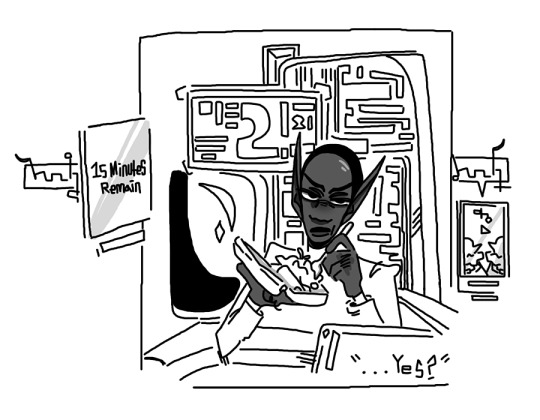
TUVOKTOBER Day 2: Lunch Break [Interrupted]
#tuvoktober#bea art tag#1000% directly inspired by that post about how Tuvok should eat tupperwear salad like a teacher#It's so true!! He literally WAS a teacher !!!#he's listening to monks chanting - his favorite music bc he's a gd freak#It's SO his favorite that Neelix knows about it. I really wanna know how he knows.#Probably 'he just asked him' but funnier: They went on an away mission and he had monk chanting playing the whole time#Neelix: (internal) This is fucking hell on earth (positive spin) At least I know his favorite music!#Everyone whose been in an older relative's car as they blast choir music (the car is always SO hot) understands#it's torture but also it's kind of comforting??? it always makes me want to got to sleep#Tuvok seems like he eats salad without dressing (maybe a light drizzle of like lemon or vinegar on top) and looks down on people#who do otherwise <3 annooooying <3#Janeway: (early in their knowing each other) Can I join you~? I'm also having a salad!#<- did this specifically to try & bond with him#Tuvok: -gazes pointedly at how much dressing she put on it- I could hardly tell.
264 notes
·
View notes
Text

"now, doesn't that look nice?" [insp]
#*chanting* skask skask skask skask-#vincent aurelius lin#adamandi#hello. let's talk about what's going on here! i've been tossing the idea about here wrt skin translucency ever since that post came out#(it's linked above fyi. but to quote it.) 'attempting to pursue this unachievable white ideal of the young academic; maybe leading to gory#representations of mimicry; replacement; taking on someone else's skin; altering the self'#this is primarily key in vincent and the skask; in the actual show iirc they used a jockey mask or smth? but i was thinking about the#delightful way skin is semi-transparent. and so a literal layer of skin alone would be unlikely to provide the whiteness pursued-#the under layer of the original tone would be there. so smth about the failure and unattainable.#additionally; at this point of the show the skin would have been likely yellowing or greying due to post-mortem development? so even more#Not white. from observations (as a kid;comparing skin tones?) white people have a pinker undertone (this might be. a generalisation but.)#here the lighting is yellowish to further push the difference + give the super harsh lighting that if you suspend disbelief has some hair#appear as blonde to further the ambrose-ness.#also the hair- messier on the non-ambrose side; a reference to the whole monologue about the haircuts they got#we bring to you also another episode of <i like drawing fabric folds> in the jacket symbolism! from bottom right to top left; it tracks#vincent throughout act two: the initial long jacket for standing out (nonchalance?) at ardess is removed; the yellow coat is put on- aided#here by ambrose's ghost which is represented by the hand! (it is very very slightly transparent- you can see the jacket pattern through it)#(if you look close) and then the satchel goes over it; this mimics the clothes in <oh ms reporter>#and then the Actual Ambrose jacket goes above along with the skask; following the outfit from the pyre scene at the end.#the spark/star thing is partially foreshadowing for the upcoming stabby eye trauma thing (@quincy) and partially just so i could highlight#the eye of the mask/ the place where vincent's eye probably is Behind the mask. because i liked the idea of merging faces; intersection.#back to the translucency of skin - you can kind of make out where the rest of his face is from the darker bit? aka it's not the same colour#as the skask. smth smth limited effectiveness...#tldr? face skin. jacket skin. altering appearance over time; unfeasibleness#when i was doing this i suddenly remembered covering my skin in talcum powder as a kid... hm. i'd forgotten about that.#anyways! when i posted my first ever adamandi thing i had the thought of 'this musical makes me want to paint' and surreally enough#that has proved to be so so true. and ngl i am really enjoying it? love it when the motivation to create is there haha#i will add as a disclaimer that i'm literally chinese and if the colours look off.. i did not mean to make a caricature. please be nice#that said because stage lighting tends to shift colours about a Lot i essentially used my own skin as a reference under yellow light?#so hopefully that checks out. <disappears>
188 notes
·
View notes
Text
Codex entry: Champions of the Just
Blessed are they who stand before
The corrupt and the wicked and do not falter.
Blessed are the peacekeepers, the champions of the just.
Blessed are the righteous, the lights in the shadow.
In their blood the Maker's will is written.
—Canticle of Benedictions 4:10-11
"When Andraste preached these verses, she offered her followers a path of virtue. "In their blood the Maker's will is written" is usually interpreted to mean sacrificing one's life for a righteous cause, but like most of the Chant, deeper meaning hides beneath the surface. "In their blood" can be understood as a reference to continuity, an unbroken line of humble behavior required to please the Maker.
Rather than a physical fight against demon or apostate, Andraste meant this verse as a warning that her faithful should judge their heart's intentions, questioning those who would lead them astray. Champions of the Just are those with the courage to admit their wrongdoing, while letting none continue in their sight.
Unsurprisingly, the Fourth Stanza is popular among militant branches of the Chantry, such as the knights-enchanter and the Templar Order."
—Notes on the Chant of Light, by Mother Bezoria of the Grand Cathedral, 9:39 Dragon
5 notes
·
View notes
Text
The Chantry and the Mythology of the Chant of Light

[Index page of Dragon Age Lore]
Dragon Age shows how Faith is a creation of a previous one, co-opted and modified to satisfy the political needs of a powerful institution in a given historical moment.
So far we saw [Chant of Light - Part 1 - Part 2 ], the faith of Andraste seems to mix in its myth several historical episodes and figures such as Andraste, her battles against the Tevinter Imperium, and her alliance with the elven slaves led by Shartan which ended up in the gift of the Dales where the elves established the Dalish Kingdom. All these events are more or less “well” recorded [they have a lot of mystical connotations to be considered truly historical] in books inside Thedas, and we can say with certainty that they were "real” events with some degree of erasure or fabrications in some moments due to political tensions.
Now, the detail of them, the truth in each of these events, may have been twisted in order to craft an appealing tale. What I mean is that we are not so sure if all those battles that were so magically "won" by Andraste were so, we don't know how much true "betrayal" existed in Masferath’s actions, as he could see at his back the many recovered Tevinter troops surrounding them, we don't know how key Shartan was for Andraste's armies to success, to the point that, maybe, without Shartan, Andraste and her armies may have been massacred by the brutal strength of Tevinter armies filled with mage warriors. Tevinter is an expansionist nation, after all, that despite Blights and constant war with Qunari, keeps an impressive strength despite its decadency. Any other nation in Thedas would have succumbed long ago, yet, Tevinter endured by any means. Specially if we take into consideration that the First Blight, the longest of the blights [it lasted almost 200 years] hit worse on Tevinter.
Now, these are the historical events that fuel the tale of the Chantry. There is, however, another component to it: the Maker.
The Maker is a fantasy character that seems to appear out of the blue in the history of Thedas with Andraste [check the brief timeline at the end of this post]. I mean, before her, this Maker was not even thought about. There was no history of the Maker before Andraste, not even proto-religions that we can assume to be related to him. There are some dark hints in Par Vollen, where the codex The Pyramids of Par Vollen seems to imply the existence of a primitive religion based on the Sun that may have been part of the original tale from which the "Maker" was created, but sadly there is no much information about this, so it remains a mere speculation.
However, as we progressively saw in all the posts of the index Dragon Age Inquistion, the similarities of Fen'Harel with the first stanzas of the Chant of Light [ Chant of Light - Part 1: Threnodies], when the Maker created two classes of creatures [spirits and humans] and then sealed the former to protect the latter, cannot be missed. This is a tale not too far from “Fen’Harel sealed the Evanuris to protect the People”, and “Fen’Harel ‘created’ the free elves by removing their Vallaslin and showing them a life of freedom”. This may suggest that the Chantry also took Elvhen history from the escapee elves who had been transmitting this tale orally for generations, and incorporated their most beloved concepts into the Chant of Light, to appeal elves as well as humans.
If we work on this train of thought, and keep in mind what we learnt about the faith that Fen’Harel inspired in his followers [Ancient Elven codices; Fen’Harel’s mountain ruins], I can see that after the creation of the Veil [which forced Solas to go into slumber to recover] Fen’Harel followers may have been left with the feeling of having been abandoned or forgotten [this coincides with the idea of the Maker abandoning his children].
With the mixture of races, specially with humans during the time of Halamshiral and the Dalish Kingdom in the Dales, I can see how the “tales of Fen’Harel”, coming from these elves were modified generation after generation and even permeating the human communities as more elf-blooded humans appeared, to the point that a figure, similar to the Maker, was all what was remembered from it. A figure that humans at that time used for political reasons as well as to conform a strong religion than may be appealing to elves as well [given the tensions that elves and humans have in different regions of Thedas]. Personally, to me, this explains quite well why Solas’ real story has so much resemblance with the first section of the Chant of Light that describes the Maker, and the prophetic similarities of the return of the maker with the “rise of the Dread Wolf”.
In this way, the Tale that will be considered sacred for the Chantry starts like a Frankenstein of small pieces of each of these cultures in order to craft a social tool that would help Thedas to stay unified and together after the brutal hit that the First Blight represented for it, while creating institutionalised propaganda against Tevinter and mages in order to keep diminishing its power and maintaining a big hatred and mistrust towards Tevinter and mages that can clearly amass a lot of dangerous power.
Historical context: Times before the Andrastian Church
Before the creation and the strong establishment of the Andrastian Church, there were two historical events that scarred the mind of the thedhosians:
The first one is the First Blight, the longest Blight in history because there were no Grey Wardens to fight it at first, and there was no knowledge about the darkspawn, the Blights, and the mechanism of effective immortality of the Archdemon. This Blight lasted almost 200 years, and during that time, Tevinter mage armies controlled the situation as much as they could, stopping their expansion all over Thedas, abandoning all their settlements [for example in the Frostback Basin [DLC]: Ancient Tevinter presence, Speculation]. It's likely that the creation of the Grey Warden is related to Tevinter in big measure, since it's undeniable the presence of griffons in the Ancient Tevinter iconography. As we explored in the Western Approach [The Still Ruins, Main Chamber and Hall of Silence], there is Grey Warden iconography in pre-blight buildings which makes little sense unless they represented another thing back then. Tevinter always was into researching blood magic too, so it seems only natural that the process of the Joining may have come from their expertise. It’s also hinted that part of this knowledge comes, originally, from Arlathan, so in that case, it’s more honest to suspect that Tevinter’s constant co-opt of Elvhenan knowledge was the responsible of the creation of the Grey Warden [some details about the origin of the blood magic in the post “Tarohne, the Fell Grimoire, and Xebenkeck”]
In the book of tabletop of Dragon Age, there is a brief comment where the Joining is suggested by some tribe person from the Donarks [north of Anderfeles], who is presented to belong to a group of people who consume the blood of their enemies to absorb their power. It feels a bit "dragon blood drinker" vibe. Sadly, this corebook has always been a weird source in DA lore, since it's not clear how to treat it: completely canon or just slight modifications of it to make a role game possible.
In any case, this book adds the obvious conclusion we reached: the Joining process may have been consulted with Tevinter Magisters as experts in blood magic, and also with slave elves, who shared "their secrets of Arlathan" [implying that Arlathan made big use of blood magic as well], bringing more questions than answers [part of this topic is treated in “Tarohne, the Fell Grimoire, and Xebenkeck”].
Anyways, the effect of the First Blight was devastating even though Thedas probably survived more [on the surface] than what it was supposed to survive thanks to Tevinter knowledge and armies, whether they like it or not to acknowledge. Of course, we have to remember that by this time the golems of Caridin were created and the dwarves kept resisting the darkspawn underground.
The second event that marked the creation of alternative strange cults of Andrastian-based tales was the historical event of Andraste and Masferath invading Tevinter after the First Blight. With her death, a second hit to the Faith of the theodosians happened. That’s how strange Forgotten Faiths appeared:
The Empty Ones: A Nevarran cult created after the death of Andraste. It lived short and worshipped the Blight and the darkspawn. They saw Andraste’s death as the beginning of the end of the world, and the Blight was the hook used by the Maker to do so. By the Second Blight, they moved to the Anderfels.
The Daughters of Song: Hedonist cult of men and women who celebrated the union of Andraste with the Maker through wine, poetry, music, and sexual acts. Emperor Drakon wiped them out in his campaign to unify Orlais.
The Blades of Hessarian: Warrior secret cult that thinks Archon Hessarian’s slave, Trefir, who was an alamarri man, carried the Sword of Mercy that killed Andraste in order to bring judgement to the world. We find this cult in DAI in the Storm Coast.
The Disciples of Andraste: We knew about this cult in DAO in Temple of Andraste. They are supposed to be descendants of the first followers of Andraste and Havard, the Avvar warrior who carried Andraste’s ashes to install her temple in Haven where we will visit later in DAO and DAI. I always found very curious the iconography used in their church [the sun imagery looks a lot like a thorny vine] and the hierarchy they had looked more similar to Tevinter Imperial Church than the orlesian one: the priest was a man called Revered Father, and a healer mage. This group was isolated all those centuries, so it seems to be fair to assume they kept their traditions as similar as those that followed Andraste when she was alive, so whatever proto-religion she embodied, it was closer to this: with mage priests, blood drinkers, and a particular love for dragons and protectors of dragonlings and eggs [a lifestyle a lot more similar to the one performed by Yavanna if you look at it]. In any case, our intervention in DAO seems to wipe them out or make them flee somewhere else. It’s known that the intricate passages around this zone were not made by the cult, it was something already built here [The Cult of Andraste, was it an Avvar hold maybe? Or ancient Tevinter? It’s almost impossible to say since DAO design was not too detailed on that matter but we certainly find unique statues of man-dragons.] We can find ancient relics in this place with alamarri runes [The Secrets of Andraste]. Translating these runes seem to link the Guardian to an “ island off the northern coast” which may be a link to Jainen? Where they find the Guardian and some relics of minor importance [Upon the Waking Sea].
This shows the level of disconnection that the people had when different cults proliferate, and the frictions that can araise causing political instability. This is the main reason why always massive religions were the best ancient tool of mass control for empires. Faith invites less critical thinking and questioning, and encourages the homogenisation of the population’s beliefs while legitimating the radical erasure or removal of anomalous or dangerous groups [such as the mages/elves in the case of the Chantry]. Through “divine right”, the powerful, political elites can determine how the system works [this is well seen when analysing Exaltations from Chant of Light - Part 2, where Kordillus implies that in a vision, Andraste names him “the Blade of Faith” and the right leader for the future of Orlais].
The presence of the Maker before Andraste
So far the game has showed us, there were three main religions before the Andrastian church:
Elvhenan one, based on the Elven Pantheon with their system of Evanuris and Forgotten Ones that we have no information about, so far. In the end we learnt that the Evanuris were not “divine” creatures but powerful Mages.
The human one in the North of Thedas, mainly Tevinter, worshipping ancient great dragons that embody the Old Gods that we have no information about either. We only know that Mythal seems to care about Urthemiel’s soul, but this tells us little about what the Old Gods truly are.
And the human one at the South of Thedas: Alamarri groups such as Chasind, Ciriane and Avvar, with their trinity of gods: The Lady of the Sky, Korth-Father Mountain, and Hakkon Winterbreath [there is also an oak-based god that appears in the canticles of “Andraste 1″ [Part 1] that I’m not sure if it was retconned or it’s a god exclusive of the Alamarri or Ciriane groups]. They seem to be one of the religions with the best comprehension of the spiritual world of Thedas.
There are also more religions or minor cults that should be mentioned:
It’s not clear for me if we can consider the Qun as another religion from the northern border of Thedas, since we don’t know exactly when the Qunari and the Qun appeared. Even though there are some in-game books and codices claiming they appeared later in Thedas, we can mistrust the accuracy of this claim due to the last reveal we had in DAI in the Tevinter Mosaics.
There are some hints of even a more ancient religion based on the Sun in The Pyramids of Par Vollen, but probably this will be explored once DA:D is released. We only have a single codex mentioning it.
Spread all over the continent, there were always cults and small religious groups that worshipped demons or dragons or any other local entities.
Curiously, there is no religion so far we know that looks like a proto-version of the Maker. One can guess that the Sun-based religion of Par Vollen [hinted in The Pyramids of Par Vollen] may be connected, but we have no more information about it at all. The other connection we have is what I've been saying in several posts before: The Maker is the humanised version of the tale of Fen'Harel, probably spread by former slave elvhen that began to suffer Tevinter slavery, the process of Dalishation, or were offsprings of interracial families [Exalted Plains].
The History of Andraste and the fight against the Tevinter Imperium
Along the games we have a broad explanation of the history of the Chantry in the codices The History of the Chantry: Chapter 1, Chapter 2, Chapter 3, Chapter 4 where we are informed by Brother Genitivi about the following:
The Chantry appears almost 400 years after the First Blight [consider that the this Blight lasted 200 years mostly]. There is a clear socio-political configuration that allows it and makes it almost “needed”. Tevinter, which has been until then an expansionist empire, the only thing that looked like “Order” which had reached deep down the South of Thedas, begins to deal with deep weaknesses:
After the First Blight, people all over Thedas are devastated in terms of their Faith: their gods allowed this terror to happen.
In Tevinter this has a worse impact causing Tevinter Faith crisis: one of their Old Gods [Dumat] had raised and attacked them, while all the pleas to the other gods were unheard. People begins to question their own religion and burn priests and temples to punish the Old Gods.
With a weakened inner structure, slave rebellions arise. Tevinter Magisters use demons and blood magic to control the situation.
Still, Tevinter has the largest army in Thedas, but it is scattered to keep control of its invaded territories and takes time to transport them back to home.
Seeing all these weaknesses the Alamarri, who had been exploited and slaved by Tevinter for an age, decide to begin an Exalted March against the empire after the end of the First Blight: their leaders are Maferath and Andraste.
Clearly, the socio-political situation of Tevinter was a unique opportunity for this military attack.
From a Chantry point of view, they justify that this situation of the Empire was a "Maker's miracle", giving to the historical event a "divine" sheen. We know what a classic argument this is in terms of our real History.
With the Tevinter faith crisis, this Exalted March easily gets Tevinter followers who felt abandoned by the Old Gods and start to believe in the Maker and his Prophet: Andraste.
This point of History is written by the Chantry with a strong emphasis against the "mages of Tevinter". It claims that Tevinter needs to be invaded because they have misused the magic “to rule over man”, and they are straight blamed for the First Blight, which is something we already know it's a lie: The Magisters did not created the Blight with their break in, and it's not even clear if they brought it either, since lore-wise, there is something underground going on. The Dwarves have quite different explanations about the origin of the Blights. But the point is that the Chantry used the Blight to enhance, justify, and legitimate its future abuse upon the mages while increasing a fear and a hate towards Tevinter. Not that is not justified, Tevinter far from an innocent nation, but it's clear the political use of the Chantry faith against Tevinter. The truth of the historical events never matter when it comes to religion used as a political and institutionalised tool.
The Chantry usually likes to ignore or diminish the key role of Shartan and his people. Without the elves leading the slave rebellions inside Tevinter, the invasion of the Alamarri forces would have never been possible [The Dales, Glandivalis]
At the Battle of Valarian Fields, the Alamarri defeated the Tevinter Army. Here is where we find another potential nasty manipulation of the History in favour of the religious myth: the betrayal of Masferath is narrated by the Chantry sources as an act of jealousy: he could not endure the fact that he was a "second husband", and that Andraste was the one receiving all the glory for this campaign. So he handed her over to the Archon of Tevinter. A more realistic approach of this event is extremely obvious if we see the map of the conquering campaign:

As it can be seen, the further the Alamarri campaign went into Tevinter, heading to Minrathous, the deeper they were fighting in Tevinter territory with all the strategical advantages that such thing has for the Empire. As the Alamarri conquered and converted towns and cities, they could not leave parts of their army in these places to hold their control, so the numberless army of Tevinter easily recovered these places after the armies of Andraste passed by. When the alamarri army reached the Valarian Fields, and headed to Minrathous, the whole path previously conquered by the alamarri has been retaken by Tevinter again. Masferath, as a strategical leader of his people [he was the one who always led these armies, not Andraste], may have seen no way for his people to survive the retaliation but to make a deal with the Archon Hessarian that ended up with Andraste's public death but guaranteeing their survival and the lands of the South for all the alamarri tribes. Nasty decision but a more realistic one than “jealousy”, although one doesn’t exclude the other. There is a beautiful documentary that explains this strategy very well: Dragon Age Lore Documentary - Exalted March . So, maybe it was not jealousy what [mainly] motivated Maferath to hand over Andraste, but pure “greater good” philosophy. Again, this is a speculation, but it feels more realistic to me that “jealousy” in a culture [alamarri] where women were always considered equals to the point to be leaders without questioning [ Tyrdda Bright-Axe Path, and check what we know about Avvar, since they come from the alamarri].
Thanks to the key participation of the elves in this invasion, and due to Andraste's promise, the elves were granted the Dales [The Dales, The Long Walk] but later the Chantry expelled them after the event of the Red Crossing [The Death of Elandrin].
After Andraste's death, people thought that the Maker had abandoned them again, so they began to look for comfort faiths: demonic cults, return to the cult of the Old Gods, and even worship of the Blight and the Darkspawn [all the ones I mentioned before].
The Cult of Andraste survived as her ashes were recovered and placed in a secret temple. This cult spread and its songs, in the form of the Chant of Light, gave form to the current Andrastian Chantry.
By the time of the Second Blight, a lot of important powerful figures had been converted: among them Kordillus Drakon, who led Exalted Marches to unify Orlais and become the first emperor of Orlais, placed the main core of the Chantry in Val Royeaux, created the Circle of Magi, the Order of Templars, and the holy office of the Divine. He also wrote the last part of the Chant of Light [Chant of Light - Part 2, Exaltations].
In this way, the Chantry was created as a political tool to unify territories, create political stability, spread biased anti-Tevinter propaganda [The Imperial Chantry] and a general anti-mage sentiment [History of the Circle, An Honest Answer Regarding Apostates], and have control over a group of people that Tevinter example showed as a danger for Thedas: the free, self-governed mages.
The Founding of the Chantry and the compilation of the Chant of Light
To close up this analysis of how the Chantry and the Chant of Light became tools of manipulation, I’ve made a brief timeline of the verse versions that were used in the modern Chant of Light accompanied with some important historical events. In this way, we can see some odd details that can make us suspect about the intention of this sacred book in Thedas. [The TE year may have some differences of one or two years since DA lore tends to be a bit messy with their own equivalences between different calendars, don’t ask devs to have a consistent maths, that’s worse than consistent lore, lol]
TIMELINE:
800 TE: First Blight starts.
805 TE: Darkspawn decimate the thaigs of the Deep Roads then emerge around Tevinter spreading terror.
Around 890 TE: Founding of the Grey Warden. It’s not a clear, well specified date. They started as a mismatch of warriors against the darkspawn, and only decades later, they developed the Joining Ritual and acquired a deeper understanding of the darkwpawn.
925 TE: Some versions of Hyms appear. The authors are unknown since this verse is a combination of tales of local god pantheons that were altered when Andraste cult began to spread.
992 TE: End of the First Blight, Dumat is killed a second time, now for good.
992 TE: Andraste is born Denerim, though date and place of her birth are hotly contested. She was born from a Ciriane mother and an Alamarri father.
1008 TE: Andraste marries Maferath.
1009 TE: Andraste is taken by a Tevinter raid and is slaved. Maferath manages to negotiate Andraste’s release. This is curious: Maferath had already negotiated with Tevinter to get what he wanted. He had his ways with Tevinter, huh.
1015 TE: Andaste leads Exalted March against Tevinter.
1025 TE : Death of Andraste. It’s known that her disciples sang a Chant composed of: Threnodies, Andraste, Transfigurations, and Trials by the time of her death. Additional verses were added later.
1030 TE: Potential origin of Andraste Verses, which author is an “Andrastian cult”. There are five hundred versions, written in Alamarri saga style. It narrates how Andraste met the Maker.
1035 TE: Archon Hessarian converts to the Andrastian church and writes Silence Verses, narrating the story of the Magister Sidereal and the origin of the Blight that happened +200 years before, clearly its accuracy is highly questioned. It’s a text made of Pro-Tevinter, Pro-Archon, and anti-blood magic propaganda.
1055 TE: Elves start The Long Walk to Halamshiral [The Dales].
1055 TE: First versions of Shartan Verses; its author is unknown, probably an elf due to the historical context. They narrate the contribution of the elves and Shartan in the Exalted March against Tevinter led by Andraste and Maferath. It is removed from the Chant after the Exalted March of the Dales in 1301 TE.
1164 TE - 1184 TE: First versions Threnodies Verses, its original author is unknown. It narrates the creation of the world, spirits, and humans.
1065 TE: First versions of Transfiguration verses, its potential author may be a Fereldan Andrastian cult. There are dozens of versions. They narrate Andraste’s sermons about how to treat magic and about her faith in the Maker.
1065 TE: Creation of the first version of the Chant of Light.
1070 TE: Hessarian dies.
1095 TE: Founding of the first Inquisition with Ameridan as leader. The institution pursuits heretics and apostate mages in the name of the Maker.
1095 TE: Appearance of the current version of Apotheosis Verses, which original verse, now lost, may have been originated around 1030 TE. Its potential author may be the original Justinia, but it may have been Havard too since he was present in the meeting with Archon Hessarian and not Justinia. This text narrates the betrayal and death of Andraste.
1170 TE: Emerius falls under its constants rebellions, becomes free from Tevinter, and renames itself as Kirkwall.
1183 TE: Origin of Exaltations. Its author is Kordillus Drakon, emperor of Orlais.
1184 TE: As the religion of Andraste becomes more and more popular and spreads, Kordillus Drakon becomes a follower of it.
1195 TE: Founding of the Chantry by Kordillus Drakon, Emperor of Orlais.
[Details of each verse and deeper analysis can be found in “Chant of the Light”, Part 1 and Part 2]
If we see a summarised timeline of the verses that belong to the modern Chant of Light, we can notice more easily all what it was commented before in this post: Before the First Blight there are no cults or signs of the Maker in any other part of Thedas, the closest we get to a proto-tale of the Maker is Fen’Harel’s tale who created the Veil, sealing entities that harmed “The People”. This tale seems to be the one which inspired Threnodies, which preserved version was written after the establishment of the free elves in the Dales [1164/1184 TE]. We know that there are some more ancient versions of this verse [1025 TE] that do not belong to the current Chant.
Immediately after the First Blight, there are no versions of The Maker either, and we only find the Hyms Verses, a group of prayers to local gods that have nothing to do with the Maker and were re-adapted to fit Andraste’s interests later. They appear before Andraste is born too, and close to the end of the First Blight. It seems natural to think that these prayers had a deeper layer of despair and need for hope: by that time, people had seen Dumat being slain and reborn immediately afterwards.
After the death of Andraste, we can spot a “Chant of Light” composed only of four Canticles: Threnodies, Andraste, Transfigurations, and Trials. Sadly, we don’t have any non-Chantry-approved version of these to compare how the different versions differ one another. Ironically, we know that these verses existed in 1025TE but the Chantry only conserved posterior versions, when the former ones may have been closer to what Andraste truly spread. More in favour of the idea that the Chantry’s Chant of Light has been manipulated beyond imagination.
Archon Hessarian converts himself to the Chantry, probably to improve the general image of Tevinter or to improve the Faith state of the nation that has been declining since the Old Gods appeared as Archdemons. At the same year of his conversion he adds his text to the Chant of Light: Silence Verses, which are a pro-tevinter propaganda. This canticle is removed from the Chant of Light afterwards, and with Shartan Verses, they belong to the Dissonant Verses [they do not belong to the canon version of the Chant of Light].
It’s also curious how the Verse of Shartan seems to appear during the time of the Long Walk to Halamshiral. Again, this makes us suspect that the mixture of elvhenan Tales with this Verse may have been a strategy to make the Chantry appealing to a great amount of immigrant free elves that establish themselves in Orlais [The Dales]. It’s better to co-opt than confront.
The current Chant of Light is finally created in 1065 TE, with a lot of verses which versions makes us suspect some manipulation. Decades later after this document has been rounded up, the Inquisition is created to deal with apostate mages and heretics, acknowledging the problem of modern mages that “want to be like Tevinter Magisters”. Here is when Apotheosis “current” version appears, narrating how Andraste is killed by “Tevinter”, the embodiment of all the “evilness that a free mage can cause”. This version probably hides a lot of inconvenient details that more ancient versions, closer to the death of Andraste in time, may have. One of my main suspicions is if the original Justinia was truly the author of this text. If she was not, her name was manipulated to make her look so in order to reinforce the idea that the Chantry should be led and preserved by women. It makes more sense, if we believe the story of the meeting with Hessarian and so on, that the one compiling this verse should have been Havard.
Finally, it seems interesting to see how Kordillus, who is managing the Great Unification of Orlais, first writes the supposed visions he had [claiming Andraste told him that he is the right leader to follow], then converts to the popular religion that is spreading in his lands, and then a decade later, founds the modern Chantry, attaching it deeply to the Orlais Empire. In this way, the religion becomes a tool to pacify, unify, and control the masses of an heterogeneous population. He may have tried to do the same with the migrant elves in the Dales, but it ended up in political frictions [plus the Second Blight] that ignited, a century later, the conflicts that ended up in the Exalted March of the Dales.
I find very impressing how well played Kordillus Drakon worked with the Chantry. He didn't only unified the territory, he even wrote part of the prophecies of the Chant of Light and wrote in them that he was the “Blade of Faith”, the “divine” leader [The world of Thedas Vol 2]. Kordillus not only was the first emperor of Orlais, and founder of the Chantry, he also appointed the only female general of his armies as the first Divine, guaranteeing a certain military and zealous mindset at the top of the Chantry.

Justinia I [general of his armies] was the responsible of picking which verses would or would not belong to the final version of the Chant, and even though the majority of the people think she is the author of the Chant as a whole, her function was mostly to collect, transcript, and “sanitise” the verses.
37 notes
·
View notes
Text
It's really crazy how every elf I see is just the most unhappy and abused person. I don't remember meeting a single happy elf in the entire series. They're all enslaved and lost and suffering and browbeaten servants. Solas please destroy the world please. don't even hesitate. right now immediately
#pull the trigger piglet#Dragon Age#playing DA:O#DA replay#JUDGE THEM WORTHY OF YOUR ENDLESS PRIDE#as the chant of light would say#they need some pride
75 notes
·
View notes